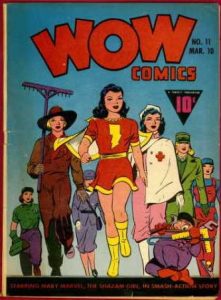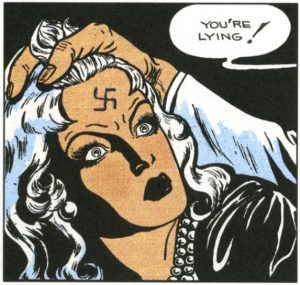Most of us have heard of Wonder Woman, the most popular female comic book superhero of all time. She was created by Harvard-educated psychologists William Moulten Marsten and H. G. Peter and introduced in All-Star Comics in October 1941. By early 1942 Wonder Woman was on the cover of a new comic book, Sensation Comics. Marsten had seen the need for a strong female superhero for young female readers to look up to. He created Wonder Woman to have the beauty of a pin up and the spirit of Rosie the Riveter. Although her skimpy dress has always been controversial, in a 1943 issue of Wonder Women comic, Martsen and Peter did have Diane Prince winning the U.S. Presidential election over the Man’s World Party – albeit 1,000 years in the future. Wonder Woman is one of many female superhero characters that were first introduced during WWII but one of the few to survive today.
Another female superhero that was introduced in the 1940s that still has a presence today in movies and comics is Mary Marvel. Not to be confused with Marvel Comics Captain Marvel (who was created as a man but recreated as Carol Marvel in the 2019 Captain Marvel movie). Fawcett comic artist Marc Swayze claimed he based Mary’s design and personality on actress Judy Garland. Mary Marvel first appeared in Fawcett Comics in Dec. 1942 and had her own comic book by December 1945. In her back story, she’s the long-lost sister on DC Comic’s Capt. Marvel, a.k.a. Billy Babson (very confusing for DC and Marvel Comics to use the same name for their characters)
Both Mary and her brother are granted their powers from the Wizard Shazam and they only have to say his name to transform into (and out of) superhero characters. You can watch the 2019’s Shazam film to learn more about these characters.
An interesting development in the world of comics occurred in late 1942, when the Office of War Information, a government agency that included a Magazine Section and a Comic Committee, suggested a subject for the next issue. This was wartime propaganda in comic book form. The OWI Magazine War Guide included the following: “WOMAN POWER IN THE WAR, the subject everybody is talking about, is a “natural” for magazine coverage. In dealing with it, however, it is advisable for editors to take into consideration the following policy decision of the War Manpower Commission: Employment of women in seemingly non-war production jobs, such as railroad, buses, streetcars, retail stores dealing with essentials, etc., should be viewed as “war work” inasmuch as women must take the places of men who have been called into the military was production service.”
The storyline to Wow Comic #11 A Telegram to Adventure, published March 10, 1943, has our superhero Mary Marvel apply and working as a Union telegram messenger after the hiring manager says “Yes, it’s true since the war began, most of our boys have left us so we’re forced to hire girls.” “Then I want the job!” Mary says. While her character goes on to help the individuals she delivers messages to, it is a clear message to young female readers that to help the war effort it’s their duty to go get a non-traditional job.
Six months before Wonder Woman debuted in All Star Comics #8 another female superhero appeared and she was created by a woman! June Tarpe’ Mills, who went by Tarpe’ Mills to avoid discrimination in the industry, introduced her comic strip in April 1941. Initially known as Black Fury, the comic was nationally distributed through the Bell syndicate. The backstory has socialite Marla Drake preparing for a masquerade party, when she learns her friend is wearing the same costume she scrambles for another outfit. She decides to wear a black panther outfit that her uncle had received from a tribal witch doctor and he willed to Marla
On the way to the party, Marla discovers her outfit makes her feel powerful and she stops an attempted murder. I another issue an imposter tries to steal her identity and henceforth Marla (and the comic strip) became Miss Fury. Miss Fury later discovered that if used too often, her suit brought her bad luck, so she only used it in life and death situations. When not wearing her panther suit, Tarpe’ Mills used her earlier career as a fashion illustrator to dress her superhero alias in chic outfits -which set her noire comic strip apart from other comics. The Miss Fury strip was full of femme fatales, criminals, and of course, Nazi villains, including Baroness Erica von Kampt, a Nazi spy with a swastika burned on her forehead (she wore bangs to hide this mark).
Miss Fury appeared in over 100 newspapers, selling millions of copies. It was also released by Timely Comics from 1942 – 1946. The image of Miss Fury also graced to the noses of several WWII bombers. Unfortunately, as women went back to traditional roles after the war there were societal pressures that now favored romantic comics with men being the center of women’s universe and Miss Fury was cancelled in December 1951.
Miss Fury creator Tarpe’ Mills became famous when her identity was finally revealed as the only female superhero creator (other women had previously written comic strips with typical female characters like Little Lulu and Brenda Starr but none broke the female stereotypical role before Mills). Mills was also ahead of her time in merchandising her work, producing Miss Fury paper dolls and sending racing pinup art to soldier fans who mailed her requests.
Tarpe’ Mills superhero had no clear occult powers but rather freed her character, Marla Drake to act beyond society norms. In M. Madrid’s 2009 book, The Supergirls: Feminism, Fantasy, and the History of Comic Book Heroines is explains “Marla didn’t play the wilting flower in order to cover up her identity of Miss Fury. She was a strong, determined woman who lived her life the way she wanted. Her Miss Fury persona was a means to an end rather than the answer to her dreams…” During WWII comics that popularized different portrayals of women’s roles were not only permitted but encouraged by government agencies. But the end of wartime brought a conservative recoil and outrage over indecent depictions of women led to the cancellation, or at least a long hiatus, of female superheroes.
Luckily today’s young girls can again be empowered by the adventures of strong female superheroes in comics and action movies. What female who saw Marvel’s End Game movie didn’t swell with pride when in the final scenes all the female superheroes teamed up to attack the evil Thanos? This was the first time in Marvel history that all the female heroes united and it was a moment worthy of applause.
To learn more: https://www.bbc.com/culture/article/20210329-remembering-miss-fury-the-worlds-first-great-superheroine




